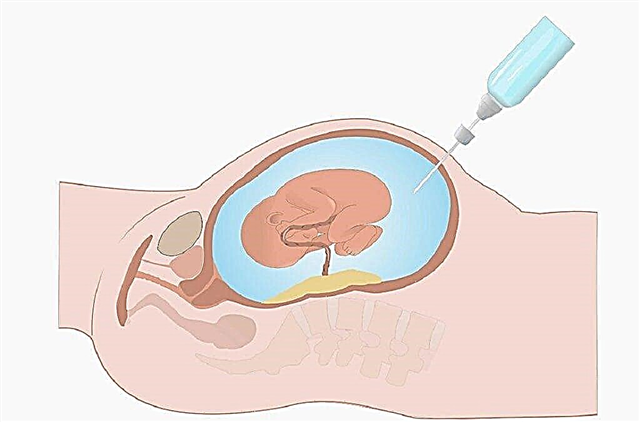About the disease
Cat cry syndrome is a genetic disease associated with the pathology of the 5th chromosome and is manifested by a large number of congenital malformations in a child. The disease got its second name (Lejeune's syndrome) thanks to the French genetist Jérôme Lejeune. In the 60s of the XX century, he first described the disease and proved the hereditary nature of the disease.
The syndrome of a cat cry is a rare disease, its frequency is 1 case in 45 thousand newborns. The disease is more common in girls, experts note the ratio of sick children of different sexes, as 1: 1.3.
The disease received its unusual name due to the specific damage to the cartilage of the baby's larynx. The crying of the baby resembles a cat's meow, which is the first sign that a child has a hereditary disease.

The reasons for the development of pathology
The disease is based on a genetic defect - the loss of a section of the short arm of the fifth chromosome. Because of this violation, the genetic information that was stored on this chromosome fragment is distorted. There are specific malformations and a characteristic clinical picture of the disease associated with changes and loss of these genes.
According to research, in 90% of cases of the disease, the cause of the pathology of the 5th chromosome is random mutations. Only in 10% of patients the hereditary nature of the disease was proven, the carriage of a genetic defect was found in the parents.
It should be noted that the syndrome of a cat cry is not associated with a change in the number of chromosomes, the presence of extra threadlike structures, for example, as in Down's disease. The genome of a child with Lejeune syndrome also consists of 46 chromosomes, as in a healthy person. The pathological process is located only in a small area of one autosome, but these changes are enough for the development of serious health problems in the baby.
Forms of the disease
Although all variants of the disease are usually called "cat cry syndrome", variations in the clinical picture of pathology still exist. The severity of the manifestations of the disease depends on the area that has undergone a change. Moreover, not only the size of the lost chromosome fragment is important, but also the localization of the defect.
The literature describes cases when a patient has a slight damage to the filamentous structure of the chromosome, but it is the dropped genes that encode all the symptoms of this pathology. In some variants of the disease, it is possible that the child has characteristic manifestations of the genetic syndrome, with the exception of damage to the bones of the larynx, voice changes.
The main types of mutations and manifestations of the disease in a child
- lack of a short arm of the 5th chromosome.
This anomaly occurs most often and is characterized by the most severe course of the disease. Due to the mutation, all the information that the chromosome arm encodes is dropped, which is approximately a quarter of the material encrypted in the autosome. In this case, the baby has numerous and severe malformations;
- shortening of the chromosome arm.
In this case, a part of the short arm is lost, therefore the material encrypted in this part of the chromosome is partially preserved. The manifestations of the disease in a child are less pronounced and depend on the number of "lost" genes;
- ring chromosome.
If the loss of a section of the chromosome is accompanied by the connection of its short and long arms, the autosome takes the shape of a circle. The severity of the symptoms of the disease depends on the size of the defect and the quality of the lost genes;
- mosaic form of the disease.
With this type of pathology, most of the cells of the baby's body have a normal genome, only a small part of them differ in changes characteristic of the cat cry syndrome. This phenomenon is explained by the fact that the mutation occurred during the development of the embryo. Initially, the set of chromosomes of the crumbs was normal, but an unfavorable factor affected the developing organism. As a result, the loss of a chromosome fragment occurred. Children with this form of the disease do not have gross defects, but their mental and mental development is impaired.

Disease development factors
- heredity.
If in the families of the parents there have been cases of the birth of children with a hereditary disease, the likelihood of a baby with cat cry syndrome increases. In such situations, expectant mothers and fathers should carefully plan the birth of a child, be thoroughly examined and consult a geneticist;
- mother's age.
The risk of chromosomal abnormalities in the unborn baby increases significantly with the age of the parents. Moreover, for the syndrome of a feline cry, the state of health and age of the mother is of greater importance than that of the father;
- bad habits.
Nicotine and drug addiction, alcohol consumption by parents significantly affects not only the state of their health in general, but can also lead to changes in the germ cells. The resulting mutations are passed on to the child, in this case the baby is more at risk of chromosomal diseases.
Exposure to unwanted substances in the early stages of pregnancy can lead to errors, chromosomal abnormalities, even with a normal genome in the embryo. In this case, the risk of developing the mosaic form of Lejeune's syndrome increases;

- infectious diseases.
Some infections can negatively affect the development of the fetus, cause mutations during cell division and lead to malformations. Especially dangerous for a pregnant woman are diseases caused by cytomegalovirus and herpes virus, which arose in the first trimester;
- taking medications.
Most modern drugs are not allowed to be consumed in early pregnancy. At the same time, improper treatment of infectious diseases, or lack of it, can cause the development of serious health problems for the mother and child. Therefore, the treatment of a pregnant woman must be approached with all responsibility; it is strictly forbidden to take medications on their own without consulting a specialist. When prescribing any medications for the expectant mother, the doctor always takes into account the possible risks and consequences for the child;
- environmental factors.
Parents living in ecologically unfavorable regions, exposure to ionizing radiation can affect the state of the reproductive system. All this affects the structure and division of germ cells and increases the risk of developing genetic diseases.
When analyzing cases of a disease, it is almost always possible to find a factor predisposing to a genetic disease. But situations have been recorded when the ailment occurred in children whose parents were absolutely healthy, and no adverse effects on their health were found.

The main symptoms of the disease
The doctor can suspect the presence of a disease in the first minutes after birth, given the characteristic signs. With insufficient severity of symptoms, determining the correct diagnosis may require a longer period of time, additional research methods.
Early manifestations of the disease
1. Low birth weight.
Although babies with the genetic syndrome usually appear on time, these children lag behind their peers in physical development - the mass of newborns rarely exceeds 2,500 g. Pregnancy in the mother of a sick child usually proceeds normally, threats of spontaneous abortion do not occur more often than in other women.
2. Crying baby.
One of the main signs by which the doctor can make a preliminary diagnosis is a change in the baby's voice. At the height of the cry, the child reproduces a sound reminiscent of a cat's meow. This phenomenon is explained by congenital defects in the development of the larynx. The unusual narrowness of the lumen, additional folds on the mucous membrane and soft cartilaginous tissue create the prerequisites for distorting the sound created by the baby.
A change in the baby's voice is a sign inherent in Lejeune's syndrome; other genetic diseases are rarely accompanied by damage to the larynx. But about 10-15% of children with this syndrome have a normal voice, which is explained by the smaller volume of the chromosome arm defect.
The high timbre of the voice remains for life in most patients. But in a third of young patients, the "cat's cry" disappears by the age of two.

3. The shape of the head.
Patients with Lejeune's syndrome are characterized by an "elongated", dolichocephalic head shape. At the same time, the baby's skull and brain are smaller, which is striking against the background of the normal size of the rest of the body. Microcephaly is detected in 85% of patients and is accompanied by mental retardation.
4. Eye symptoms.
When examining a newborn, a specialist notices the unusual shape of the baby's eye slits. The manifestations of this disease are characterized by: wide fit of the eyes, antimongoloid incision of the palpebral fissures (the outer corners of the eyes are located below the inner ones), the presence of a special fold - the epicant in the inner corner of the eye. A careful examination of the child often reveals congenital cataracts, myopia, strabismus, optic atrophy.
5. Low-set ears.
Auricular ptosis is often combined with various pathologies and underdevelopment of cartilage. Ears may differ in shape, and the auditory meatus is often narrowed, additional formations in the parotid region are possible.

6. Hypoplasia of the lower jaw.
With abnormal development of the lower jaw, micrognathia is observed, a decrease in its size. In addition to aesthetic problems, this pathology leads to malocclusion, abnormal growth of teeth, deepening of the jaw inside the mouth. Newborn children often have difficulties with sucking, the small lower jaw is not able to properly take part in the sucking act, the necessary pressure is not created in the oral cavity. Often the pathology of the jaw is combined with clefts of the palate and upper lip, cleft tongue.
7. Damage to the osteoarticular system.
Examining the baby's hands, you can find fingers curved in the joints - clindactyly. Deformation of the fingers is manifested in a change in their position, the phalanges look "beveled" in relation to the axis of the limb.
Often, anomalies of the fingers are manifested by fusion - syndactyly, associated with insufficient separation of them in the embryonic period. The septum connecting the fingers can be either a soft tissue, skin structure, or a bone formation.
The defeat of the osteoarticular system of the lower extremities can be manifested by clubfoot. In this case, the baby's foot is deflected inward from the longitudinal axis of the lower leg, and attempts to bring it to its normal position are unsuccessful. The appearance of other anomalies is not excluded - flat feet, congenital dislocation of the hip, scoliosis.
Each of the above signs individually does not have a diagnostic value in the diagnosis of Lejeune syndrome. Many of them can be observed with various genetic diseases. A combination of several symptoms is of great importance in determining the disease, the main of which are the characteristic crying of the baby and eye defects.

8. Congenital malformations.
This genetic syndrome is not limited only to the external manifestations of the disease, pathologies of internal organs are of much greater importance. Often, babies are born with severe heart and kidney defects. The gradually increasing failure of these organs often leads to the death of the infant in the first year of life.
The life expectancy of children with scream syndrome depends on the severity of the chromosomal mutation and the combination of developmental defects. According to statistics, only 10% of patients survive to adolescence. In rare cases, with a mild form of the disease, life expectancy can be up to 50 years.
Manifestations of the disease at an older age
- mental retardation.
Grown-up babies with scream syndrome differ significantly from their peers. Due to the presence of microcephaly, the child's intellectual development is impaired. The baby is difficult to learn speech, with difficulty memorizing simple concepts. The mental retardation can range from imbecility to idiocy;
- delayed physical development.
Children with the genetic syndrome learn motor skills late. In connection with the underdevelopment of the brain, the centers responsible for the coordination of movements also suffer. It is difficult for the baby to maintain balance, which is manifested by frequent falls, disturbed gait. Reduced muscle tone, characteristic of this disease, worsens the development of the baby;
- features of behavior.
Such children are characterized by pronounced emotional lability. Frequent mood swings are manifested by a sharp transition from laughter to tears, hysterics. Kids are prone to hyperactivity, and in a team they often show aggression;
- somatic diseases.
The main problems of most babies are poor eyesight, constipation, diseases of the cardiovascular, osteoarticular and urinary systems. The severity of clinical manifestations depends on the form of the disease.

Diagnosis of the disease
The detection of the disease consists of several stages and begins with the examination of future parents. Then the diagnosis of pathology in a newborn baby comes to the fore.
Genetic counseling
At the stage of pregnancy planning, in cases where chromosomal diseases occurred in the families of future parents, the couple should consult a geneticist. The specialist will help you calculate the risk of having a child with hereditary pathology and advise you to undergo karyotyping. Using this method, you can determine the genome of the parents' cells and the deviations in the structure of chromosomes.
Screening examinations
Detection of many genetic diseases, including the syndrome of a cat cry, is possible even before the birth of a child. To this end, all women need to be examined in a timely manner in the antenatal clinic. After examining and questioning the expectant mother, the gynecologist will recommend an ultrasound scan and donate blood for specific markers.
With these methods, it is impossible to accurately establish the syndrome of the cat cry. Changes in research results can be nonspecific and indicate many genetic diseases, such as Down syndrome, Patau syndrome, Edwards, and others. Based on the data obtained, the doctor can recommend a more accurate diagnosis.
Invasive research methods
These procedures include amniocentesis, cordocentesis, and chorionic biopsy. With the help of these studies, it is possible to obtain material for the analysis of the child's genome. The accuracy of the methods reaches 99%, which serves as the basis for resolving the issue of the need for early termination of pregnancy.
While such studies provide important information, they are quite traumatic. The risk of spontaneous abortion after the procedure is about 1%.

Examination of a born child
A preliminary diagnosis is made to the baby while still in the maternity hospital by a neonatologist.To confirm the pathology of the patient, the baby is consulted by a geneticist, cytogenetic studies are carried out to analyze the number and structure of chromosomes.
A child with a diagnosis of cat cry syndrome requires a thorough examination (clinical and biochemical blood and urine tests, ECG, ultrasound, radiography), consultations of many specialists, since pathological changes can appear in different organs.
Treatment
There is no special therapy for a genetic disease; currently, it will not find a way to influence the structure of chromosomes. Treatment of the baby should be aimed at restoring the function of the affected organs, correcting visual acuity, neurological disorders, and developing motor and speech skills. Often, children are given medication and physiotherapy, massage courses, exercise therapy. Families with a special child need to be consulted by a psychologist.
Prevention of the disease
To prevent the occurrence of genetic diseases in a child, expectant parents should take a responsible approach to planning pregnancy. It is important long before conception to exclude factors predisposing to the disease, to lead a healthy lifestyle.
Families with cases of hereditary diseases need to be especially careful. In such a situation, genetic counseling is indispensable. During pregnancy, a woman must timely undergo all the proposed examinations, which enable the doctor to suspect deviations in the development of the baby.

Conclusions
Although genetic diseases are relatively rare, they are characterized by severe, difficult to correct abnormalities. The birth of a special child in a family is a huge shock and test for parents. Having heard the diagnosis of "cat cry syndrome", moms and dads should find out how the disease is progressing and what changes in the child's health can be expected.
Parents-to-be should remember the importance of pregnancy planning, pre-conceptional preparation and consult a specialist in a timely manner. By following the doctor's recommendations and taking care of your health, you can significantly reduce the risk of a serious pathology in a child.



